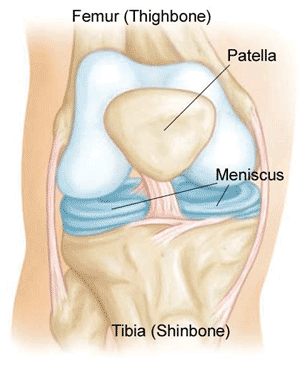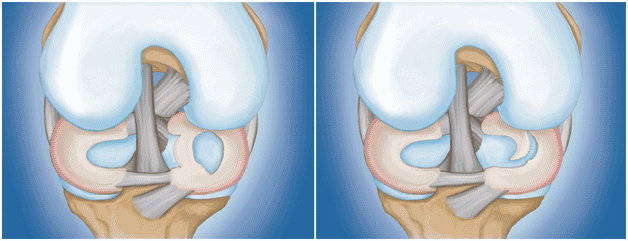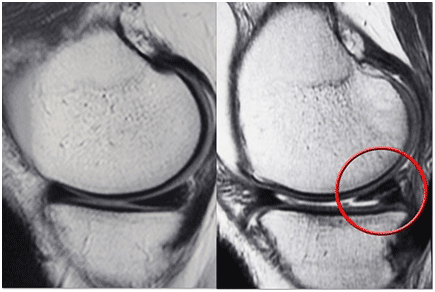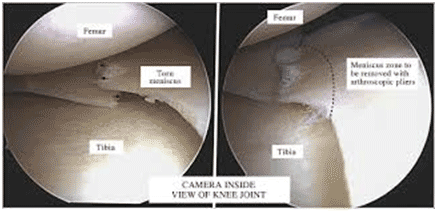 Does your knee hurt? Does it ever buckle, snap, or catch? Have you had an injury where your knee was twisted quickly and you heard or felt a pop? If so, then you may have a meniscus tear. Meniscus tears are a common injury that can cause pain and discomfort in the knee. Things that you may feel with a meniscus tear may include pain, swelling, and stiffness in the knee joint. Some individuals may also experience a popping sensation at the time of the injury. The pain may worsen with activities that put pressure on the knee, such as walking, running, or bending.
Does your knee hurt? Does it ever buckle, snap, or catch? Have you had an injury where your knee was twisted quickly and you heard or felt a pop? If so, then you may have a meniscus tear. Meniscus tears are a common injury that can cause pain and discomfort in the knee. Things that you may feel with a meniscus tear may include pain, swelling, and stiffness in the knee joint. Some individuals may also experience a popping sensation at the time of the injury. The pain may worsen with activities that put pressure on the knee, such as walking, running, or bending.
This type of pain occurs because of how the meniscus is designed. If you look at a knee joint you can see that it is made of a thigh bone (the femur) and a leg bone (the tibia) There is also a knee cap(patella) that helps to stabilize the knee when we walk, run and climb stairs. The meniscus lives in the space between the femur bone and the tibia and it acts as a cushion and it provides stability to help keep your knee in place. As we age and use our legs more and more the meniscus tissue can wear out and this leads to tearing of the tissue and often times pain.
As a person gets older, the meniscus tends to naturally wear out and yet most people with meniscus tears have NO pain at all. That being said, in certain patients the pain can be quite limiting and bothersome. If a person’s knee is causing them difficulty with walking, climbing stairs, running or even sleeping, then going to a healthcare provider such as an orthopaedic surgeon can be helpful to obtain a diagnosis and treatment.
Types of meniscus tears:
(Left) Flap tear (Right) bucket handle twE

Diagnosing a meniscus tear typically involves a physical examination by a healthcare provider, as well as imaging tests such as an MRI or X-ray. These tests can help the healthcare provider determine the extent of the tear and develop an appropriate treatment plan. X-rays are important to evaluate the knee for arthritis, Or degeneration of the joint as this can cause similar symptoms. Most of the time a meniscus tear can be diagnosed with a good history and physical exam, but an MRI is almost always obtained in order to fully understand the type of tear that is present.

MRI scans show (left) a normal meniscus and (right) a torn meniscus. The tear can be seen as a white line through the dark body of the meniscus.
*Adapted from OrthoInfo-AAOS
Treatment for a meniscus tear depends on the severity of the injury. In some cases, non operative treatments such as rest, ice, and physical therapy and steroid injections may be recommended to help reduce pain and swelling. Nonsteroidal anti-inflammatory drugs (NSAIDs) may also be prescribed to help manage pain and inflammation. In more severe cases, surgical intervention may be necessary to repair or remove the damaged portion of the meniscus, especially if a patient has tried the non operative measures and they have failed to provide relief.

Illustration and photo show a camera and instruments inserted through portals in a knee.
*Adapted from OrthoInfo-AAOS
Surgical treatment for a meniscus tear may involve arthroscopic surgery, a minimally invasive procedure that allows the healthcare provider to repair or remove the damaged tissue through small incisions in the knee. In most cases, the frayed, torn and damaged tissue can be removed in order to improve a patients pain. In this proceudure a small portion of the meniscus is removed leaving most of the tissue behind. In very certain types of tears, a repair may warranted. This typically occurs in younger, more aggressively active patients and your surgeon will discuss this with you further if necessary. Following surgery, physical therapy may be recommended to help strengthen the muscles around the knee and improve range of motion. With proper treatment and rehabilitation, many individuals are able to recover from a meniscus tear and return to their normal activities. In cases where just a clean up job was done, a patient can be back to normal activity, often as soon as 4-6 weeks ofter surgery. IN cases of repair, the knee needs to be protected from weight bearing for 6-12 weeks post op, typically. The outcomes of treatment for a meniscus tear can vary depending on the individual and the severity of the injury. In many cases, conservative treatments and physical therapy can help reduce pain and improve function in the knee joint. However, in some cases, surgical intervention may be necessary to fully repair the meniscus and restore knee function. By seeking prompt medical attention and following the recommended treatment plan, individuals can improve their chances of a successful recovery from a meniscus tear.
In conclusion, meniscus tears are a common injury that can cause pain and discomfort in the knee. By recognizing the symptoms and seeking timely medical attention, individuals can receive an accurate diagnosis and appropriate treatment to help alleviate pain and improve function in the knee joint. With a combination of conservative treatments and, in some cases, surgical intervention, many individuals are able to successfully recover from a meniscus tear and return to their normal activities.
If you are having pain in the knee, it could be a meniscus tear. Give us a call at Wisconsin River Orthopaedics and we can help you find the answer to your knee pain and guide you down the path to recovery.